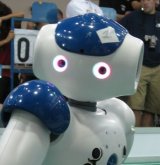The Chin Pinch: A Case Study in Skill Learning on a Legged Robot
The Chin Pinch: A Case Study in Skill Learning on a Legged Robot.
Peggy
Fidelman and Peter Stone.
In Gerhard Lakemeyer, Elizabeth
Sklar, Domenico Sorenti, and Tomoichi Takahashi, editors, RoboCup-2006: Robot Soccer World Cup X, Lecture Notes
in Artificial Intelligence, pp. 59–71, Springer Verlag, Berlin, 2007.
Some videos
referenced in the paper.
Download
[PDF]186.9kB [postscript]1.6MB
Abstract
When developing skills on a physical robot, it is appealing to turn to modern machine learning methods in order to automate the process. However, when no accurate simulator exists for the type of motion in question, all learning must occur on the physical robot itself. In such a case, there is a high premium on quick, efficient learning (specifically, learning with low sample complexity). Recent results in learning locomotion have demonstrated the feasibility of learning fast walks directly on quadrupedal robots. This paper demonstrates that it is also possible to learn a higher-level skill requiring more fine motor coordination, again with all learning occurring directly on the robot. In particular, the paper presents a learned ball-grasping skill on a commercially available Sony Aibo robot, with no human intervention other than battery changes. The learned skill significantly outperforms our best hand-tuned solution. As the learned grasping skill relies on a learned walk, we characterize our learning implementation within the layered learning formalism. To our knowledge, the two learned layers represent the first use of layered learning on a physical robot.
BibTeX Entry
@incollection(LNAI2006-peggy,
author="Peggy Fidelman and Peter Stone",
title="The Chin Pinch: A Case Study in Skill Learning on a Legged Robot",
booktitle= "{R}obo{C}up-2006: Robot Soccer World Cup {X}",
Editor="Gerhard Lakemeyer and Elizabeth Sklar and Domenico Sorenti and Tomoichi Takahashi",
Publisher="Springer Verlag",address="Berlin",year="2007",
issn="0302-9743",
isbn="978-3-540-74023-0",
series="Lecture Notes in Artificial Intelligence",
volume="4434",
pages="59--71",
abstract={
When developing skills on a physical robot, it is
appealing to turn to modern machine learning methods
in order to automate the process. However, when no
accurate simulator exists for the type of motion in
question, all learning must occur on the physical
robot itself. In such a case, there is a high
premium on quick, efficient learning (specifically,
learning with low sample complexity). Recent
results in learning locomotion have demonstrated the
feasibility of learning fast walks directly on
quadrupedal robots. This paper demonstrates that it
is also possible to learn a higher-level skill
requiring more fine motor coordination, again with
all learning occurring directly on the robot. In
particular, the paper presents a learned
ball-grasping skill on a commercially available Sony
Aibo robot, with no human intervention other than
battery changes. The learned skill significantly
outperforms our best hand-tuned solution. As the
learned grasping skill relies on a learned walk, we
characterize our learning implementation within the
layered learning formalism. To our knowledge, the
two learned layers represent the first use of
layered learning on a physical robot.
},
)



